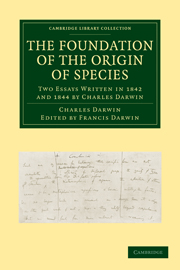Book contents
- Frontmatter
- Contents
- INTRODUCTION
- PART I
- PART II
- PART I
- PART II ON THE EVIDENCE FAVOURABLE AND OPPOSED TO THE VIEW THAT SPECIES ARE NATURALLY FORMED RACES, DESCENDED FROM COMMON STOCKS
- CHAPTER IV ON THE NUMBER OF INTERMEDIATE FORMS REQUIRED ON THE THEORY OF COMMON DESCENT; AND ON THEIR ABSENCE IN A FOSSIL STATE
- CHAPTER V GRADUAL APPEARANCE AND DISAPPEARANCE OF SPECIES
- CHAPTER VI ON THE GEOGRAPHICAL DISTRIBUTION OF ORGANIC BEINGS IN PAST AND PRESENT TIMES
- CHAPTER VII ON THE NATURE OF THE AFFINITIES AND CLASSIFICATION OF ORGANIC BEINGS
- CHAPTER VIII UNITY OF TYPE IN THE GREAT CLASSES; AND MORPHOLOGICAL STRUCTURES
- CHAPTER IX ABORTIVE OR RUDIMENTARY ORGANS
- CHAPTER X RECAPITULATION AND CONCLUSION
- INDEX
CHAPTER VI - ON THE GEOGRAPHICAL DISTRIBUTION OF ORGANIC BEINGS IN PAST AND PRESENT TIMES
Published online by Cambridge University Press: 07 September 2010
- Frontmatter
- Contents
- INTRODUCTION
- PART I
- PART II
- PART I
- PART II ON THE EVIDENCE FAVOURABLE AND OPPOSED TO THE VIEW THAT SPECIES ARE NATURALLY FORMED RACES, DESCENDED FROM COMMON STOCKS
- CHAPTER IV ON THE NUMBER OF INTERMEDIATE FORMS REQUIRED ON THE THEORY OF COMMON DESCENT; AND ON THEIR ABSENCE IN A FOSSIL STATE
- CHAPTER V GRADUAL APPEARANCE AND DISAPPEARANCE OF SPECIES
- CHAPTER VI ON THE GEOGRAPHICAL DISTRIBUTION OF ORGANIC BEINGS IN PAST AND PRESENT TIMES
- CHAPTER VII ON THE NATURE OF THE AFFINITIES AND CLASSIFICATION OF ORGANIC BEINGS
- CHAPTER VIII UNITY OF TYPE IN THE GREAT CLASSES; AND MORPHOLOGICAL STRUCTURES
- CHAPTER IX ABORTIVE OR RUDIMENTARY ORGANS
- CHAPTER X RECAPITULATION AND CONCLUSION
- INDEX
Summary
For convenience sake I shall divide this chapter into three sections1. In the first place I shall endeavour to state the laws of the distribution of existing beings, as far as our present object is concerned; in the second, that of extinct; and in the third section I shall consider how far these laws accord with the theory of allied species having a common descent.
SECTION FIRST.
Distribution of the inhabitants in the different continents.
In the following discussion I shall chiefly refer to terrestrial mammifers, inasmuch as they are better known; their differences in different countries, strongly marked; and especially as the necessary means of their transport are more evident, and confusion, from the accidental conveyance by man of a species from one district to another district, is less likely to arise. It is known that all mammifers (as well as all other organisms) are united in one great system; but that the different species, genera, or families of the same order inhabit different quarters of the globe. If we divide the land into two divisions, according to the amount of difference, and disregarding the numbers of the terrestrial mammifers inhabiting them, we shall have first Australia including New Guinea; and secondly the rest of the world: if we make a three-fold division, we shall have Australia, S. America, and the rest of the world; I must observe that North America is in some respects neutral land, from possessing some S. American forms, but I believe it is more closely allied (as it certainly is in its birds, plants and shells) with Europe.
- Type
- Chapter
- Information
- The Foundation of the Origin of SpeciesTwo Essays Written in 1842 and 1844 by Charles Darwin, pp. 151 - 197Publisher: Cambridge University PressPrint publication year: 2009First published in: 1909



